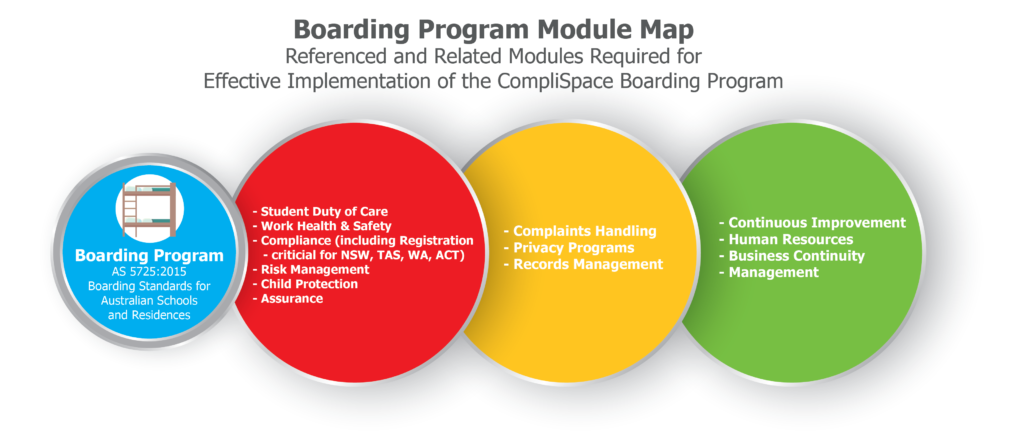There are nearly 200 non-government schools in Australia that cater for boarders. In addition, there are many government-run residential colleges both within and outside of the metropolitan areas where school-aged students from many schools, including non-government schools, may board.
From a school perspective, where a school has a boarding facility, it is simply not suitable nor valid to assume that the boarding house is able to run independently of their associated day school. Of course, this does not include external residential colleges. However, because boarding houses are so specific and quite unique in how they care for and how they work with students, they are sometimes seen (or they would prefer to be seen) from within their school as a separate entity. One school has recently described their boarding house as follows: "If we were a country, our boarding house would consider itself to be a principality within the country!" However, as has been recently identified in several states and territories through regulation, boarding is considered to be only one component of the overall registration process for schools.
A school with a boarding facility can jeopardise the duration of its current or future period of registration by having a negative report regarding its boarding service. In addition, a glowing report for boarding will not necessarily save a school that has a negative report for governance, finances or perhaps educational outcomes. The school is reviewed as a whole and boarding is seen as one component of its overall offerings.
For example, the new Education Regulations 2017 (Tas) include a section on Student Welfare in the Standards for Renewal of Registration of Registered Individual Schools. Clause 6(3) states that “a registered individual school must have one or more policies relating to…if the individual registered school operates a boarding house, the safety and welfare of students accommodated at the boarding house.’’ The same obligation applies to a system of non-government schools.
If we were to review a boarding service on the basis of the risks associated with this essential school activity, the interrelationships between boarding and other areas of risk within a school can be summarised by this simple diagram:

In our first article published in School Governance this week, we noted that one manner in which boarding schools can ensure that they are engaging in proactive child protection behaviours in their boarding facilities, in addition to legislated state and territory requirements, is to adopt AS 5725:2015 Boarding Standard for Australian schools and residences (AS 5725 or the Standard) as a model of best practice. Schools may wish to refer to our online resources for more information about compliance with the Standard. However, the Standard is now listed in the 2017 WA Registration guidelines and updated NT Education Act with other jurisdictions anticipated to follow. Boarding registration requirements are also noted in the NSW and TAS registration guidelines.
In addition, and following on from the CompliSpace recent webinar, The Boarding School Enigma – Balancing Enterprise Risk Management and Student Care, presented by CompliSpace Managing Director David Griffiths, the feedback we received from the Webinar indicated that many schools still remain uncertain on the extent of their legal and regulatory obligations and the most effective ways to manage their boarding risks.
If we refer to the diagram, the colours and position of the main areas of risk have been chosen to highlight their close association with a school boarding program. It is absolutely clear that student duty of care, Work Health and Safety, child protection and the actual practice of risk management must be very heavily embedded within any boarding compliance program and they would probably be dealt with at a school level as well as within the boarding program. To a lesser but no less important position, complaints, privacy, records, human resources and business continuity management would also involved.
Schools should not silo their boarding facility nor allow each boarding house to silo itself from the others. Issues such as child protection, student duty of care and Work Health and Safety must be mitigated for in each boarding house and in a similar manner as in the remainder of the school. From a cultural perspective, allowing for a separation of the risk management process could be a very dangerous activity in which to engage or to allow to engage. Yes, it is essential that each boarding house within a school should have its own identity, however they must all have the same cultural foundation, the same identification of and mitigation of risks and the same expectations of their students.
There is no doubt at all that schools today are better versed in their general understanding of risk management then they were ten years ago. It can also be argued that every single facet of the operation of a school touches upon risk management. Developing a holistic, online, risk management framework allows a school to understand the types and level of risk inherent in its business. This includes the risks associated with its boarding facility. However, some schools seem to have been managing their risks on a divisional basis with each department, boarding house or sub-school identifying, overseeing and mitigating their own risks. In the business world, this method of managing risks was found to be ineffective against many types of risk because they were often highly interdependent.
The Victorian Department of Education gives a very good example of a type of interdependent risk that helps to explain this concept: "Young people may often experience multiple risk factors, which may be interdependent. For example, family breakdown may be a factor in substance misuse, which may itself contribute to other problems such as offending behaviour."
At a school level, what this means is that risks cross inter-departmental lines. If they are managed in different ways by different people, each area develops its own response to a risk and it increases the chance that the interdependency of a number of risks is less likely to be identified. More alarmingly, some risks can then slip through the cracks altogether.
In her article, ‘Guide to ERM: Interdependence of Risks’, Alice Watson writes: "In the context of enterprise risk management, potential interdependence of risks should never be ignored: It’s built into the very name—the enterprise-wide nature—of the discipline. But understanding how different risks relate to one another is a very difficult question."
A holistic framework (or Enterprise Risk Management (ERM)) should outline the school’s approach to risk, as well as outlining the risks themselves. It also helps to establish and develop a risk management culture within the school that is applied to the boarding facilities as well. It assists schools to understand how different risks relate to one another.
Heads of Boarding who attempt to run their boarding facilities as an independent entity (in a vacuum) within the school run the very real risk of:
- developing a sub-culture within their boarding house that does not sit with the school’s culture;
- having risks that are either not identified, not mitigated effectively because they are interdependent, or completely missed; and
- jeopardising the tenure of the school’s re-registration period.
Boarding risks are, therefore, one component of the internal, stakeholder and external macro risk categories which need to be considered holistically in order for a school to manage its risks consistently and cohesively. The likelihood and consequence of a boarding risk will ultimately depend upon the school’s overall risk management process and how it rates other kinds of risks. Invariably, a school’s policies and procedures for boarding should be well integrated in their overall approach to policy management.
Boarding, by its very nature, must be interdependent within the school, not only from a risk perspective but also from a cultural and compliance perspective too. How can a school consider their boarding program to be holistic if it sits within a vacuum?




